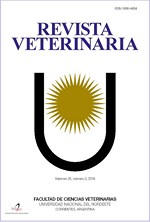Evaluation of ruminal development of woolly lambs and half blood Santa Inés lambs
DOI:
https://doi.org/10.30972/vet.3024130Keywords:
Sheep, growth, biotype, ruminal development, sex, weightAbstract
In recent years, studies on the growth and development of certain animal organs and their implications for their future productivity have been emphasized. The objective of the present work was to evaluate the ruminal development of woolly lambs and halfblood Santa Inés lambs at different slaughter weights. The trial was conducted in Monte Caseros Department, Corrientes Province, Argentina. A batch of sheep of dual-purpose woolly biotype (Ideal base), was used. For the service, half of the woolly sheeps were crossed with Santa Inés males, and the other half with Ideal breeding animals, which were synchronized. The test was carried out with the woolly lambs and half-blood Santa Inés lambs (woolly females x males Santa Inés). The experimental approach used was a factorial design by biotype, sex and slaughter weight. Five animals were slaughtered by biotype (wool and half-blood), sex (males and females) and by each slaughter weight: 10, 17 and 24 kg (30 males and 30 females). The samples were fixed and then subjected to routine histological processing. The morphometric analysis were performed using an image analyzer system. The thickness of the mucous membrane, epithelium and muscle tunic of the rumen were determined, as well as the length and amplitude of the papillae, obtaining the averages of the measurements. The data were subjected to a multivariate statistical analysis, making correlations between the variables, analysis of principal components and analysis of the variance. The most influential variables in the process of ruminal development were length and width of papillae, thickness of the epithelium and thickness of the muscular wall. The largest sizes of them were observed in the animals slaughtered at 24 kg of live weight. It appears that the half blood biotype affects the development of the variables, more in females than in males.
Downloads
Downloads
Published
How to Cite
Issue
Section
License
Revista Veterinaria (Rev. Vet.) maintains a commitment to the policies of Open Access to scientific information, as it considers that both scientific publications as well as research investigations funded by public resources should circulate freely without restrictions. Revista Veterinaria (Rev. Vet.) ratifies the Open Access model in which scientific publications are made freely available at no cost online.










.jpg)
.jpg)



